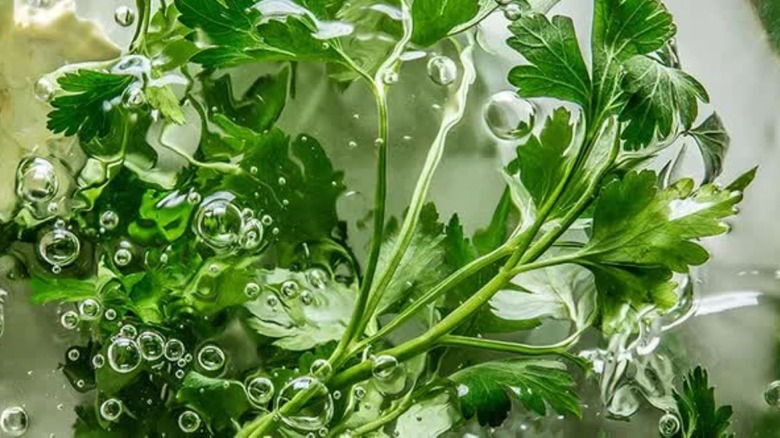What To Do With Leftover Parsley: Broth, Pesto And More Ideas
What to do with leftover parsley
We may receive a commission on purchases made from links.
April is Homegrown Month at Tasting Table.
It seems like some sort of cruel joke to have to buy a full bunch of parsley when you need just a tablespoon or two chopped. But until it's sold by the sprig, we'll continue to find creative ways to use our leftovers. Sure, you can always add it to a pesto or chop and freeze it in white wine or olive oil. But here are a handful of new ideas for using up the last of your leafy herb.
Parsley Broth
If you're in the habit of making chicken or vegetable stock, then you have an automatic way to use up those extra leaves and stems. If not, you can always just make a simple parsley broth instead. Elizabeth Stark of Brooklyn Supper makes a broth with parsley, a few cloves of garlic, and onions if she has them around, which she then uses to poach fish or cook grains with more flavor than water alone.
Smoothies and Juices
Even if you're skeptical of the whole green juice explosion, you can't deny that adding parsley to your morning drink is a great way to use it up quickly. Even better, parsley is a relatively neutral flavor when juiced, so it won't overpower even a fruit-based smoothie. You'll also reap a variety of health benefits, according to Hayden Slater, co-founder and CEO of Pressed Juicery. "Parsley is an excellent source of magnesium; is rich in vitamins A, C, B12, and K; and is a great digestion aid," Slater says. The herb might be small, but when it comes to nutrition, it sure is mighty.
Salads
Parsley is an essential ingredient in Levantine grain salad tabbouleh. Paired with bulgur wheat, tomatoes, cucumbers, and mint, it makes for a refreshing spring side dish or a healthy lunch. But parsley livens up all kinds of other salads or a freestyle riff with your favorite grains and roasted vegetables.
Meatballs
The easiest way to take your meatballs to the next level is by adding parsley, Frank Castronovo of Frankies Spuntino says. "It helps balance the flavor and adds a freshness to the meatball." The same goes for making hamburgers: Adding about a quarter cup of chopped parsley leaves to your favorite burger blend helps keep the meat from tasting too heavy.
RELATED Don't Throw Out Stems and Skins
Pickles and Fermenting
When getting your pickling spice ingredients together, don't forget the parsley. It might not be a traditional addition, but it adds flavor to even quick pickles. Once you're ready to take your preserving a step further, consider making fermented parsley. Kirsten Shockey, author of Fermented Vegetables: Creative Recipes for Fermenting 64 Vegetables & Herbs in Krauts, Kimchis, Brined Pickles, Chutneys, Relishes & Pastes, makes a fermented parsley paste that's great as part of herbed butter or a rub for chicken.
Blitz one bunch of parsley, half a teaspoon of salt and two or three cloves of garlic in a food processor to make a paste. (It will be fairly dry since you aren't adding oil.) Scoop the paste into a half-pint glass jar. Fit a zippered plastic bag into the jar, pressing down to make sure the plastic is in contact with the surface of the paste—you don't want any air to escape. Then fill the plastic bag with water and let it sit on top of the paste (to keep air out) for three to five days to ferment. After that, keep it in your fridge for up to six months.
